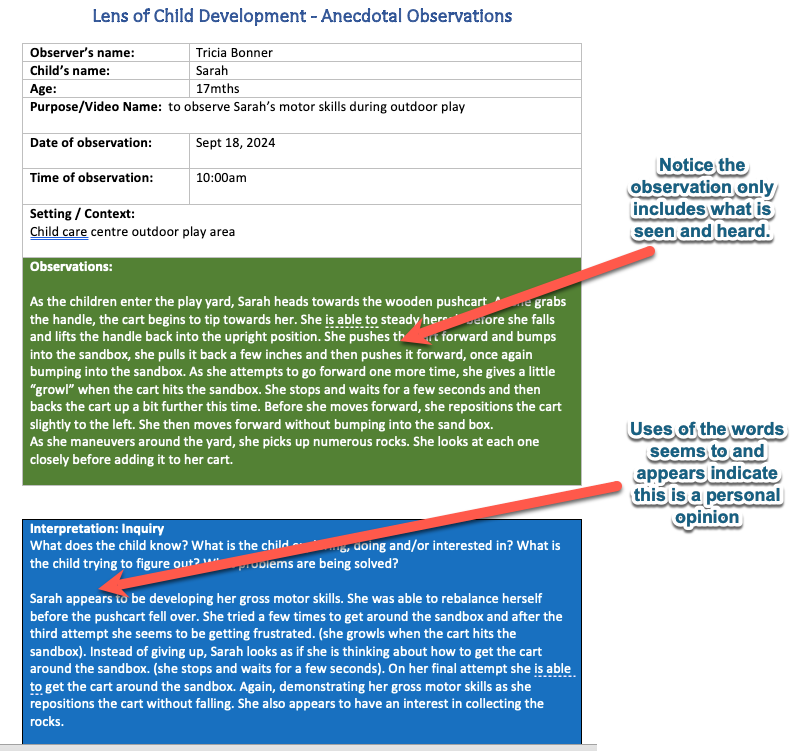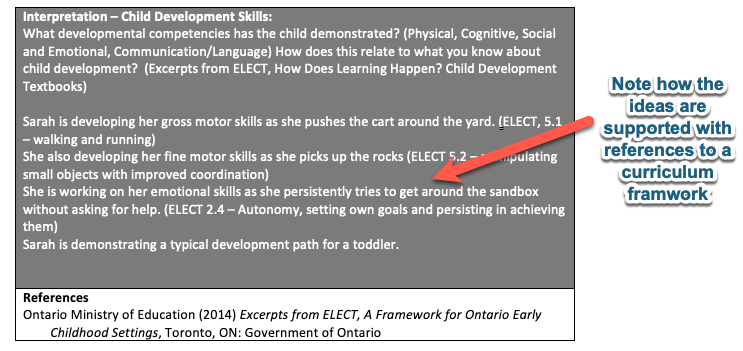9 Anecdotal and Running Records
This chapter will explore different types of methods you can use to document children’s learning. Which one you choose will depend on what you’re observing, the purpose of your observation, and the amount of time you have. For instance, if you’re trying to document the progression of a child’s grip on a crayon or pencil as they write or draw, it would be helpful to capture that developmental progression with pictures. If you’re hoping to get a better idea of the reason behind a child’s challenging behaviour, jotting down your observations would be more useful than a picture. There are some methods that allow educators to take note of what’s happening as it’s happening, and this can be great to capture exact quotes. Unfortunately, educators often don’t have the time or ability to do that, so we would complete our documentation as soon as we’re able to and use a method that allows us to record key details as we remember them after the fact.
There are many different scenarios that dictate what our documentation will look like and what methods educators can use. We will consider 2 situations that occur typically and regularly each day in early learning environments.
- Methods used to capture spontaneous observations
- Methods used to capture specific behaviours
In this chapter, we will explore two methods we use to capture spontaneous observations:
- Running records
- Anecdotal records
Running Record
One of the oldest observation methods used in early child education is the running record. Running records are considered by some as an “informal method” of observation because evidence is gathered in a spontaneous and informal manner as it occurs. This method provides rich, detailed evidence and written accounts of everything you see and hear a child doing during a specific timeframe.
The primary goal for using a Running record is to “obtain a detailed, objective account of behaviour without inference, interpretations, or evaluations” (Bentzen, 2009). You will know you have gathered good evidence when you can close your eyes and you can “see” the images in your mind as they are described in your Running record.
Collecting Your Data
All you need is time, paper and a pen to gather your observation evidence. The goal of a running record is to write down everything you see and hear exactly as it occurs without adding any comments or attaching any opinions. As the saying goes, “just the facts, ma’am!” With the running record format, not only will you highlight children’s behaviours, you will record the setting, situation, and sequence in which the behaviour occurred. Be as descriptive as possible and yet also as concise as possible. Since you’ll be documenting while you observe, write in the present tense. Children move quickly, so you must write quickly. When conducting a running record, you need to be out of ratio because your full attention can’t be on the children while you’re so focused on writing. You will need to step back and observe from a distance. Don’t interfere with the child’s natural play, ask questions, or run after them. Be as invisible as possible.
Organizing your Data
As you collect rich, detailed data throughout the year, you will begin to recognize patterns of development, and you will see each child’s unique attributes, personalities, and abilities as they emerge. Be sure to date all your running records; having numerous children in your classroom can add up to a lot of running records. You will need to store your running records safely in a portfolio or file folder. When it comes time to assess a child’s development, you will be able to look back and review all the evidence you have collected and monitor the child’s progress over time.
Note: A running record is an ideal observation method for ECE students since educators may not always have the time or staff coverage to conduct a running record due to how time-consuming it is.
Advantages
There are lots of advantages to selecting running records:
- Provide detailed data about the who, what, where, and when
- Evidence is documented as it occurs, in a sequence
- Provide objective and descriptive evidence
- Appropriate for gathering baseline information about the child’s interests, abilities and skill level
- Ideal for tracking a child’s development over time
- Less structured, more free flowing
- Interpretations and reflections can be added later
Disadvantages
Like every method we will be discussing, there are some drawbacks to running records:
- Time consuming
- May be difficult to keep up and follow along as children move quickly from one activity to another
- Not a practical technique for educators who are in ratio
Let’s take a look at two different running records. As you look through them, consider the following questions:
- What did you “see” with this example? What was the setting, situation and sequence of events?
- What did you learn about the child (Jorge)?
- Was the evidence objective? Was the evidence descriptive?
Example 1:
Running Record: On 7/2/2019, Jorge played in the sandbox for 20 minutes.
Example 2:
Running Record: 7/2/2019. Time: 10:10am
During outside play and exploration, the following activities were available: bikes, sandbox, sensory table with goop, hula hoops, balls and a reading area with a basket of books. Jorge played in the sandbox for 20 minutes. With his left hand, Jorge dug a hole using a shovel. Jorge asked Julissa if he could have the dinosaur, “When you are finished, can I have the dinosaur for my cave?” Julissa handed Jorge the dinosaur and said, “Can I see?” Jorge nodded his head up and down.
At 10:30am, the teacher announced that it was time to clean up. Jorge stood up, dropped his shovel, ran over to the door and got in line. While in line, Jorge waved his hands and said “Come on Max. Come on. Here. Come here.” Max ran over and stood next to Jorge in line.
Pin It
All children are different. They don’t learn or develop in the same ways. Using observation tools like anecdotes and running records can inform educators how to adapt to the different needs of children.
Anecdotal Records
An anecdotal record is a direct observation of a child that offers a window of opportunity to see into a child’s actions, interactions and reactions to people and events. It is an excellent tool that provides educators with a collection of narratives that can be used to showcase a child’s progress over time. Anecdotal records provide brief notes that are focused on a specific event or activity.
They are different from running records in that they are completed after the observation rather than during, so you’re jotting down your recollection of what you observed. Because of this, anecdotal records are usually less detailed, shorter, and include fewer direct quotes.
COLLECTING YOUR DATA
To gather effective observation evidence using this method, reflect the following guidelines:
1. Include accurate and specific details of the event (vivid descriptions exactly as you see and hear them happening – do not summarize, assume or make judgments)
2. Include the context, setting and situation that surrounds the event (the where, when, who, what, and how)
3. Record objective facts about the child’s behaviour and interactions (report actions and conversations)
4. Write records in the past tense (because you’re documenting after the fact)
You’ll notice that the guidelines are essentially the same as those for running records, except you’ll just change your verb tense.
Organizing Your Data
Once you have completed the anecdotal record, you will interpret the data. Look for patterns and note whether the data reflects typical or unusual behaviour for the child. To measure a child’s developmental progress, look for their strengths (skills and milestones that have been mastered) and their needs (skills and milestones that the child needs further support with). The summary notes help you to clarify instructional recommendations (adjustments that you can make to the environment to better support the child’s learning and development). The notes you take can help you generate developmentally appropriate lesson plan activities and interactions. All anecdotal records need to be dated and stored safely.
Advantages
Here are some advantages to using anecdotal records:
• Provide vivid details about the who, what, when, where and how
• Take less time to write up an observation compared to running records
• Evidence is documented as it occurs, in a sequence
• Include objective and descriptive evidence
• Interpretation notes can be added afterwards
• No special training is required
• Provides qualitative data over time and is helpful in tracking changes in a child’s development over time
Disadvantages
Some drawbacks of anecdotal records include the following:
• Data can be tainted since it is not written in the moment, so we’re relying on our memory
• Focus on one event, situation or behaviour at a time and can miss or overlook important information
• May not always report a child’s typical pattern of development or behaviour


Wrap it Up
Anecdotal records are a useful method for documenting significant events or actions that tells us something about the child’s development, interests, skills, abilities and needs. Such as observing a child climbing on the playground equipment will provide information on their gross motor development or observing a child crying during drop offs will tell you about the child’s social/emotional development. This observation is usually recorded after the event has occurred and written in past tense. It should focus on what is significant and recorded in sequential order. It may focus on a single area of development or cover a number of developmental areas at once. When observing using an anecdotal method, record what the child had said and done, body language, direct quotes, body language, facial expressions and tone of voice.
Running records tell a story of the child’s behaviour by detailing everything a child says during a set period of time. They are written in present tense since you are recording as it happens. Running records provide a more detailed account of a child’s behaviour in particular situations. They are useful in determining why a child is behaving in a particular way and usually provide in depth information on a range of developmental areas. With running records it is often a good ideas to record during a specific time (2 to 5 minutes) or observe during time increments.

